في عالم المشاريع المعقدة، لا بد من التسليم في الوقت المحدد.
ففي نهاية المطاف، فإن تفويت المواعيد النهائية يشبه وضع لافتة مضيئة تقول غير موثوق به للعملاء. ولضمان النجاح، فإن اعتماد نهج تخطيط واقعي ودقيق أمر بالغ الأهمية.
قد لا تكون لديك قدرات خارقة، ولكن لديك طريقة المسار الحرج.
يمكن أن تساعدك هذه التقنية الفعالة في تعزيز إدارة مشروعك من خلال التحليل الدقيق لتبعيات المهام والتسلسلات الحرجة 💥
تشرح هذه المقالة طريقة المسار الحرج وفوائدها وحالات استخدامها وعناصرها الرئيسية. كما ستوفر أيضًا إرشادات خطوة بخطوة وتقترح بعض الإرشادات المفيدة برامج إدارة المشاريع لجعل تنفيذ طريقة المسار الحرج أسهل، حتى بالنسبة للمبتدئين.
ما هي طريقة المسار الحرج؟
طريقة المسار الحرج هي سلسلة أو تسلسل من المهام التي يجب القيام بها والتي تحدد الجدول الزمني العام للمشروع. نطلق على هذه المهام الأنشطة الحرجة، وهي ضرورية لتنفيذ المشروع بنجاح وفي الوقت المناسب. ⏲️
إن طريقة المسار الحرج، والمعروفة أيضًا باسم تحليل المسار الحرج (CPA)، هي تقنية يستخدمها مديرو المشاريع لوضع جداول زمنية دقيقة على امتداد المشروع بأكمله. ويقومون بذلك عن طريق تحديد المهام التابعة الحرجة عن طريق حساب مدتها باستخدام صيغة متخصصة (أو خوارزمية المسار الحرج).
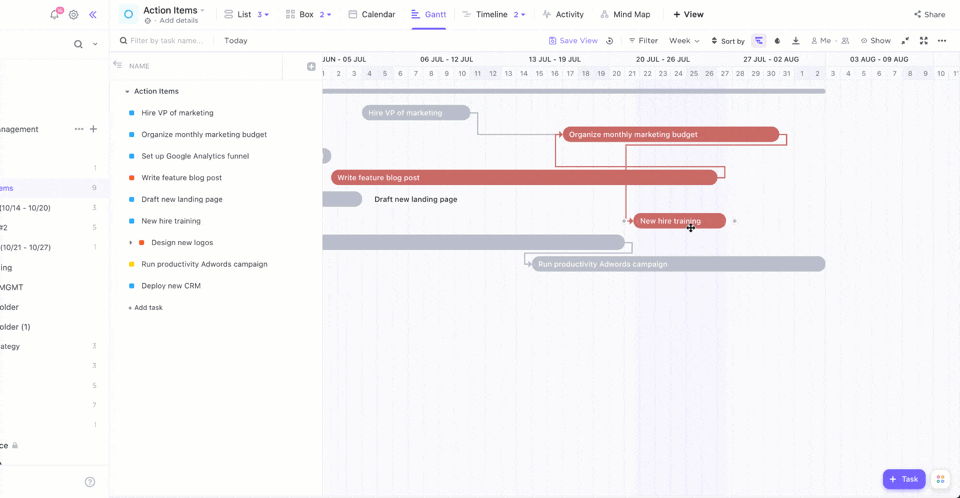
يمكنك الاطلاع بسهولة على الجدول الزمني للمسار الحرج والجدول الزمني والأنشطة في عرض مخطط جانت القابل للتخصيص بالسحب والإفلات في ClickUp
كما أنها غالبًا ما استخدام مخططات جانت أو غيرها من الرسوم البيانية لتصور وفهم أفضل ل الجدول الزمني للمشروع . يستخدمه مديرو المشاريع للحصول على نظرة شاملة للمشروع بأكمله والمهام التابعة له لاتخاذ قرارات أفضل.
تم تطوير هذه الطريقة في الخمسينيات من القرن الماضي على يد جيمس إ. كيلي من شركة ريمنجتون راند ومورغان ر. ووكر من شركة دوبونت، اللذان كانا يتطلعان إلى خفض التكاليف المرتبطة بالجدولة غير الفعالة. كما اخترع الزوجان أيضاً تقنية تقييم ومراجعة البرامج (PERT)، وهي طريقة مشابهة غالباً ما تستخدم إلى جانب طريقة المسار الحرج.
ميدود المسار الحرج مقابل بيرت PERT
يعد كل من CPM و PERT كلاهما منهجيات إدارة المشاريع للتخطيط والجدولة. وخلافاً لمنهجية التسيير الإداري للمشاريع، وهي نموذج حتمي، فإن منهجية PERT هي منهجية احتمالية بمعنى أنها تأخذ في الاعتبار مجموعة من الفترات الزمنية المحتملة لكل مهمة لتوفير تقدير أكثر مرونة للجدول الزمني.
للتعمق أكثر في الاختلافات بينهما، راجع الجدول أدناه:
| طريقة المسار الحرج | PERT |
|---|---|
| - تُستخدم عندما تكون مدة المهمة معروفة- موجهة نحو النشاط- أفضل للمهام المتكررة- تركز على المفاضلة بين الوقت والتكلفة- تحسب أقرب وآخر أوقات البدء والانتهاء للمهام بناءً على التبعيات الخاصة بها- تُستخدم عندما تكون مدة المهمة غير معروفة- موجهة نحو الحدث- أفضل للمهام غير المتكررة- تركز على الوقت فقط- تحسب المدة بناءً على ثلاثة أنواع من التقديرات- متفائلة ومتشائمة والأكثر احتمالاً |
فوائد استخدام طريقة المسار الحرج في إدارة المشاريع
سيجد مديرو المشاريع العديد من الفوائد لاستخدام طريقة المسار الحرج، بما في ذلك:
- التقدير الدقيق: بفضل طريقة المسار الحرج، يمكنك إجراء تنبؤات ووضع توقعات واقعية والتخطيط بنجاح لبقية المشروع
- تخطيط فعّال: يمكنك بسهولة إنشاء جدول زمني منظم وواقعي وقابل للتكيف لمشروع المسار الحرج، وتجنب الانتكاسات الكبيرة نحو إنجاز المشروع
- تحديد أولويات المهام: طريقة المسار الحرج تساعدك على تحديد المهام الحرجة التي يجب أن تكون على رأس قائمة أولوياتكقائمة الأولويات والترتيب الأكثر منطقية لإكمالها
- تحسين الموارد: بمجرد أن تعرف ما يجب إنجازه ومتى وبأي ترتيب، يمكنك تعيين العمل بشكل فعال وتخصيص موارد أخرى
- تحسين التواصل: من خلال جدول زمني محدد ومصور، من الأسهل التأكد من أن الجميع على نفس الصفحة، مما يساهم في سير العمل بشكل أكثر سلاسة
متى يتم استخدام طريقة المسار الحرج
يجب إجراء تحليل المسار الحرج في بداية دورة حياة المشروع. يتم إجراؤه عادةً في مرحلة التخطيط قبل الجدولة. في بعض الحالات، يقوم مديرو المشاريع بإجراء ذلك في وقت أبكر من ذلك وإدراجه في مقترح المشروع .
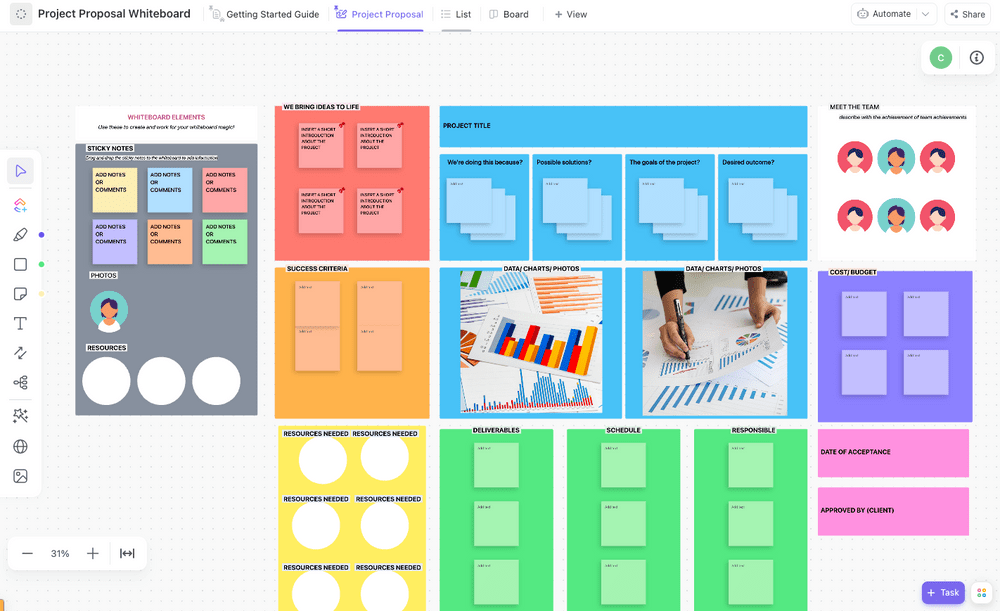
قم ببناء مقترح مشروعك بسهولة باستخدام ClickUp Whiteboards لرؤية كل خطوة أو مرحلة من المشروع بشكل مرئي
الصناعات التي تتعامل مع المشاريع المعقدة، مثل الإنشاءات والهندسة، وتخطيط الأحداث، هي الأكثر استفادة من طريقة المسار الحرج. إلى جانب المشاريع التي تنطوي على العديد من الأجزاء المتحركة، يمكن أن تكون طريقة المسار الحرج مفيدة أيضًا عندما يتعلق الأمر ب الوقت أو المشاريع ذات الموارد المحدودة . 🚨
المكونات الرئيسية لطريقة المسار الحرج
قبل أن نبدأ في استكشاف طريقة المسار الحرج خطوة بخطوة، دعنا نتعرف على مفاهيمها الرئيسية ومعناها. اعتبر القسم التالي بمثابة مسرد مصطلحات طريقة المسار الحرج! 📖
أنشطة المشروع
في طريقة المسار الحرج، يمكن أن تكون الأنشطة حرجة أو غير حرجة. الأنشطة الحرجة هي تلك التي تحددها على أنها مهمة وتدرجها في المسار الحرج. أنشطة المشروع غير الحرجة هي جميع المهام الأخرى. وهي أقل حساسية للوقت أو ضرورية، مما يمنحك المزيد من المرونة في الجدولة.
إليك مثال مبسط: إذا كان مشروعك عبارة عن بناء منزل، فإن وضع الأساس وتركيب السقف يعتبران من الأنشطة الحرجة، بينما تندرج الديكورات الداخلية ضمن فئة الأنشطة غير الحرجة. 🏠
تبعيات المهام
الأنشطة لها علاقاتها، أي التبعيات. ما يعنيه ذلك هو أنها يجب أن تحدث بترتيب معين. على سبيل المثال، يجب أن تنتهي بعض المهام التابعة قبل أن تبدأ المهام الأخرى، أو يجب أن تبدأ في وقت واحد.
للاستمرار في مثال بناء المنزل - لا يمكنك البدء في تأثيث الغرفة قبل الانتهاء من الأرضيات وطلاء الجدران بالكامل. 🛋️
مخطط المسار الحرج للشبكة
مخطط المسار الحرج للشبكة هو مخطط انسيابي ل تصور الجدول الزمني لمشروعك وتبعيات المهام. وهو يتكون من عقد، والتي عادةً ما يتم تمثيلها بمستطيلات أو دوائر، وموصلات، أي أسهم.
إن تصور هيكل الأنشطة بهذه الطريقة يجعل من السهل فهم وتحديد الأنشطة الحرجة. يبرز مخطط المسار الحرج أحيانًا المناطق بألوان مختلفة لتمييزها عن تسلسل المهام غير الحرجة.
يمكنك أيضًا استخدام مخططات جانت ومخططات بيرت (PERT) لتصور الجدول الزمني لمشروعك والمسارات الحرجة، ولكن المزيد عن ذلك في قسم الكيفية! 👀
الصيغ والمقاييس
تتكون طريقة المسار الحرج من سلسلة من العمليات الحسابية لتحديد مدة المهام والمسار الحرج. المقاييس الأساسية هي:
- أقرب وقت بدء (ES): أقرب تاريخ ممكن لبدء النشاط مع مراعاة التبعيات
- أقرب وقت انتهاء (EF): أقرب تاريخ ممكن يمكنك فيه إكمال نشاط ما مع الأخذ في الاعتبار ES ومدته
- أقرب وقت بدء (LS): آخر تاريخ ممكن يمكنك فيه بدء نشاط ما قبل التسبب في تأخير كبير للمشروع
- آخر وقت إنهاء (LF): آخر تاريخ ممكن يمكنك فيه إكمال مهمة ما استنادًا إلى آخر موعد ممكن لإكمال المهمة بناءً على مدة التنفيذ ومدة إنجازها
- مدة المهمة (ر): إجمالي الوقت المستغرق لإكمال نشاط ما
تتكون معادلة المسار الحرج من جزأين، سنشرحهما أدناه.
تمرير إلى الأمام
نستخدم التمرير الأمامي ل حساب ES و EF.
سيكون ES للنشاط الأول في أي مسار دائمًا 1 لأنه يشير إلى البداية، أي اليوم الأول من مشروعك.
يساوي ES لجميع الأنشطة الأخرى أقرب نقطة نهاية للنشاط السابق زائد 1:
ES \= EF للنشاط السابق + 1
يساوي EF مجموع ES ومدة النشاط ناقص 1:
EF \= ES + t - 1
المرور العكسي
من خلال التمرير العكسي، نقوم بحساب LS و LF.
سيكون LF للنشاط الأخير في أي مسار هو نفسه دائمًا، لأنه يشير إلى النهاية، أي اليوم الأخير من المشروع.
LS للنشاط يساوي الفرق بين LF ومدة المهمة زائد 1:
LS \= LF - t + 1
يساوي الفرق بين LF لنشاط ما يساوي LS للنشاط التالي ناقص 1:
LF \= LS للنشاط التالي - 1
العائم/النقصان
ال عائم أو راكد يمثل المدة التي يمكن أن تتأخر فيها مهمة غير حرجة دون التأثير على الجدول الزمني للمشروع بأكمله. لا تسمح المهام الحرجة بالتأخير، لذا فإن درجة تعويمها تكون تلقائيًا 0.
هناك نوعان من التعويم:
- التعويم الكلي: مقدار التأخير الذي لا يؤثر على تاريخ إنجاز المشروع (LS أو LF - ES أو EF)
- التعويم الحر: مقدار التأخير الذي لا يؤثر على تاريخ بدء المهمة التالية (ES للنشاط التالي - EF للنشاط الحالي)
كيفية حساب المسار الحرج في إدارة المشاريع
الآن بعد أن أتقنت جميع عناصر طريقة المسار الحرج، حان الوقت لاختبار معرفتك. في هذا القسم، سنوضح لك كيفية حساب المسار الحرج لمشروعك في ست خطوات. 🧮
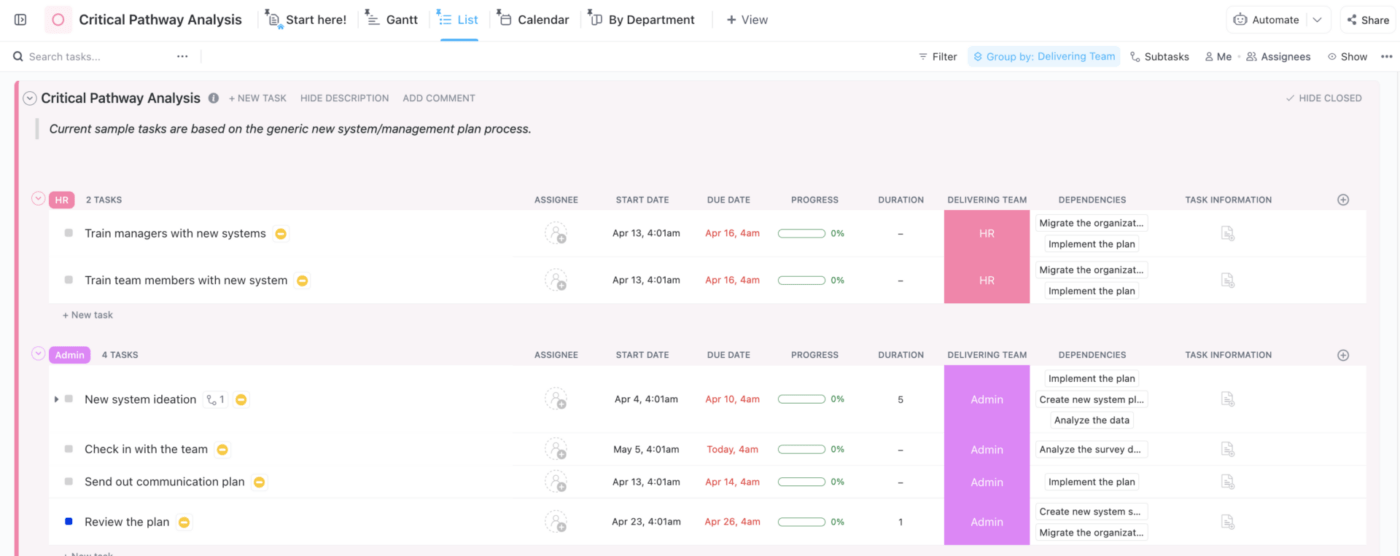
فرز المهام أو تصفيتها أو تجميعها لرؤية أفضل في قائمة ClickUp
نصيحة احترافية: إذا اخترت أداة إدارة المشروع مثل انقر فوق يمكنك إعفاء نفسك من العمل اليدوي والمتكرر. فبدلاً من البدء من الصفر، استخدم أداة قالب تحليل المسار الحرج ClickUp .
مع العديد من إدارة المهام ميزات ومخططات Gantt البديهية، هذه الأداة تجعل إدارة المهام أكثر سهولة وانسيابية! 🙌
الخطوة 1: إنشاء قائمة بالمهام
أول شيء يجب عليك فعله هو تحديد نطاق المشروع. اجمع كل أنشطتك في مكان واحد وحدد أهدافك وميزانيتك والموعد النهائي.
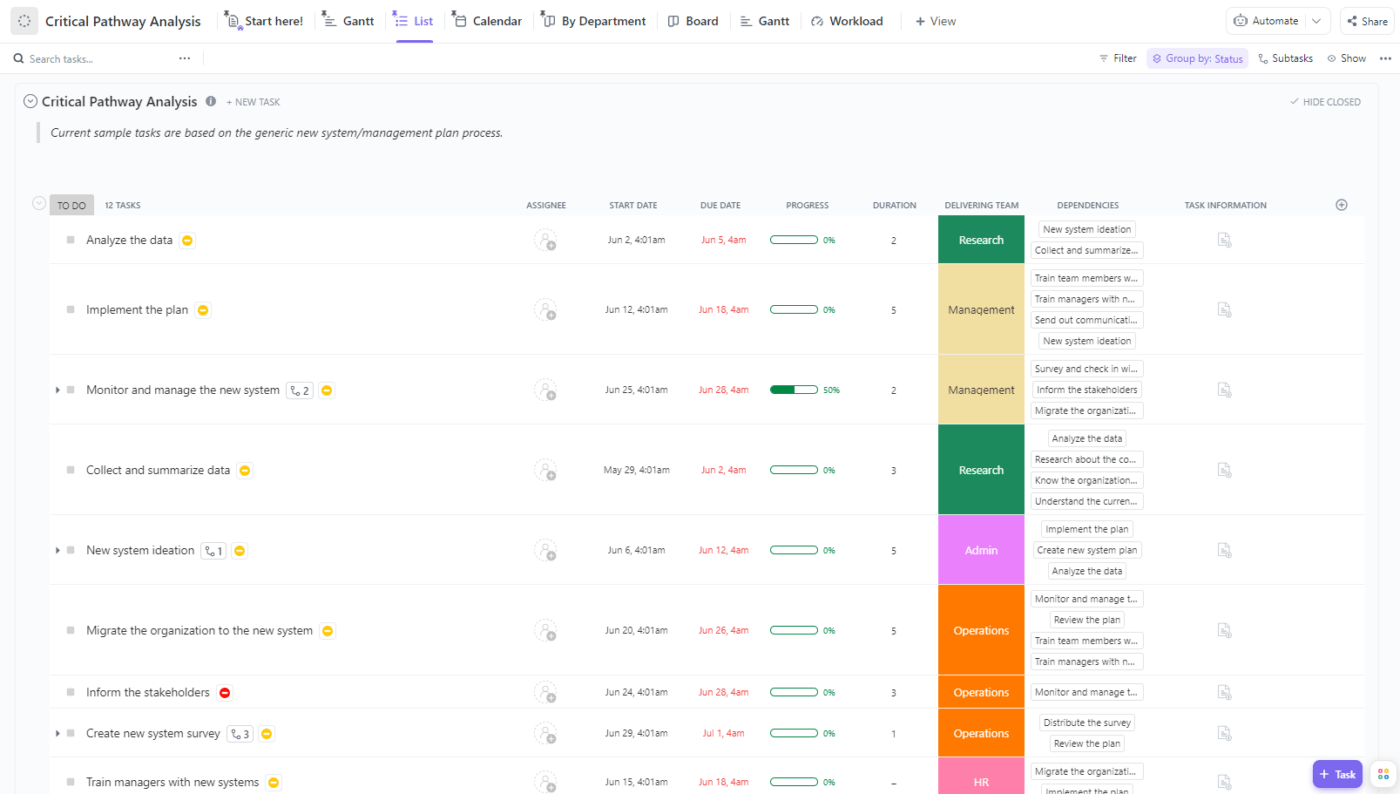
سرد جميع المهام في المشروع لتحديد نطاقه
توفر لك طريقة عرض القائمة في ClickUp إطار عمل مثالي لذلك. إنه جدول بيانات يمكنك فيه إدراج جميع المهام والمهام الفرعية والمعلومات ذات الصلة بها في حقول مخصصة، مثل
- تواريخ البدء والاستحقاق
- المدة الزمنية
- القسم المسؤول
- المستندات المصاحبة
لا تتردد في إضافة حقول مخصصة أخرى للمساعدة في تخطيط مشروعك. لديك أكثر من 20 نوعًا من الحقول تحت تصرفك، بما في ذلك القائمة المنسدلة وخانة الاختيار والتصنيف وشريط التقدم.
إلى جانب سرد المهام، يمكنك أيضًا تعيينها وإرفاق الملفات وقيادة المناقشات مع فريقك في التعليقات.
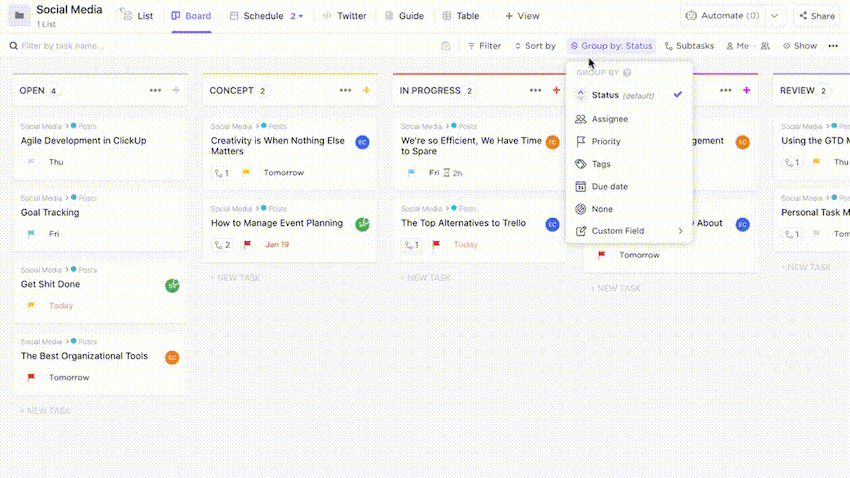
قم بتخصيص نظام إدارة المشروع الخاص بك عن طريق ترتيب الأعمدة لتناسب تفضيلاتك مثل الحالة والمُعيَّن والأولويات والمزيد
ألست من محبي جداول البيانات والقوائم؟ يمكن لمديري المشاريع القيام بكل شيء على غرار كانبان عرض لوحة ClickUp Board كذلك للبقاء على اطلاع على الجدول الزمني للمشروع، والكشف عن قيود الموارد، والاطلاع على التقدم الفعلي نحو إنجاز المشروع.
الخطوة 2: تحديد تبعيات المهام
يعد التحديد الدقيق للتبعيات أمرًا بالغ الأهمية لنجاح تقدير الوقت والتخطيط. ناقش مع فريقك واستخدم خبراتك السابقة لـ تحديد الترتيب الأكثر منطقية للمهام.
لتحديد علاقات المهام في ClickUp، انقر بزر الماوس الأيمن على مهمة وحدد الخيار التبعيات. يمكنك الاختيار بين ثلاثة أنواع:
- انتظار على: المهام التي يجب إكمالها قبل المهمة المحددة
- حظر: المهام التي لا يمكن بدء تشغيلها قبل اكتمال المهمة المحددة
- مرتبطة: المهام المرتبطة بالمهمة المحددة ولكنها لا تعتمد على المهمة المحددة
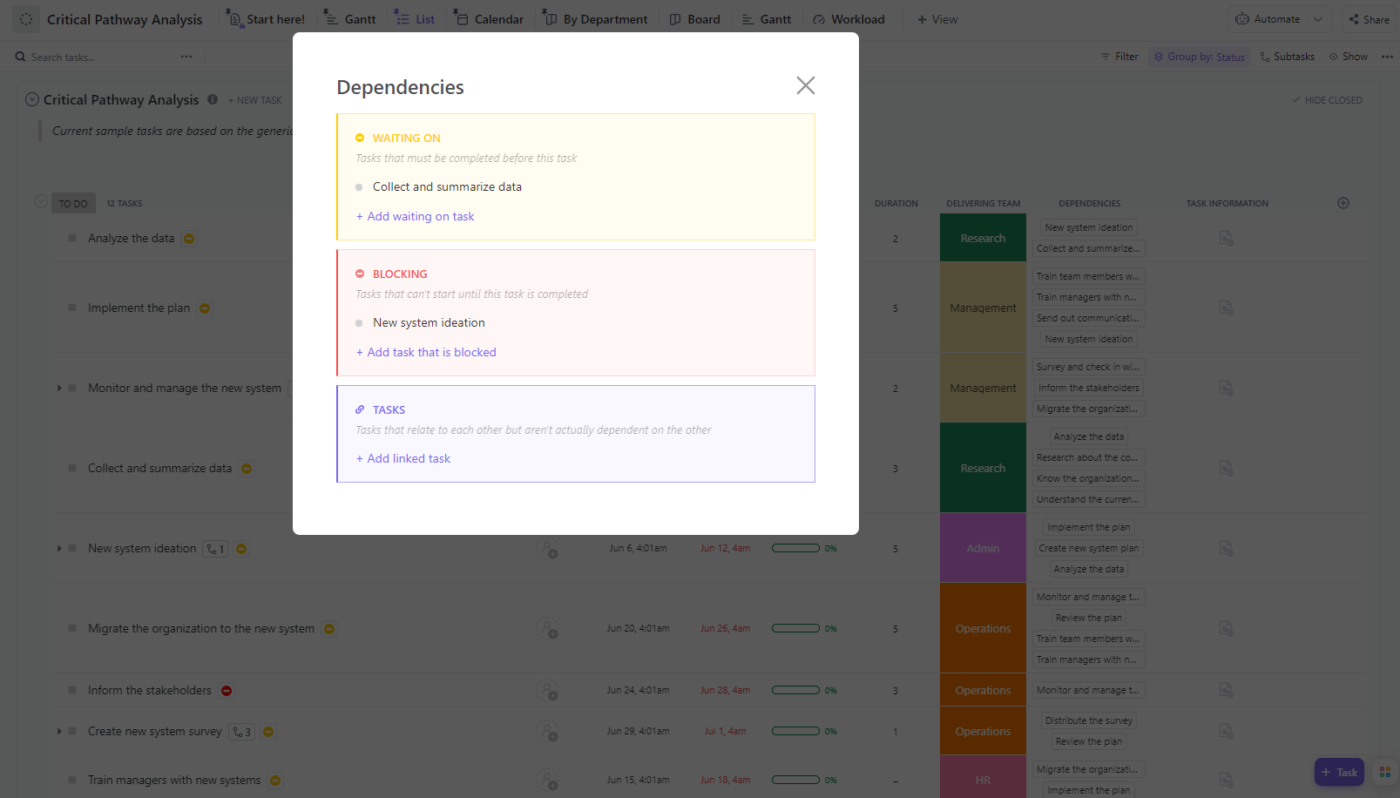
التوصل إلى الترتيب المثالي للمهام
تحديد العلاقات أسهل في طريقة عرض جانت. ما عليك سوى تحديد النقطة الموجودة على أي من جانبي شريط المهام وسحبها إلى النقطة المقابلة في المهمة الأخرى.
أفضل جزء هو أن طريقة العرض هذه تسمح لك بإعادة جدولة المهام التابعة تلقائيًا. لتنشيطه، افتح القائمة المنسدلة إظهار وقم بالتبديل إلى خيار إعادة جدولة التبعيات.
الخطوة 3: تصور
استخدم مخطط الشبكة, هيكل تقسيم العمل (WBS) , مخطط بيرت أو أي طريقة تصور أخرى لجعل بنية مهام المشروع المعقدة أكثر قابلية للفهم. ارسم المخطط الانسيابي و رتب المهام بناءً على ترتيبها الزمني وتبعياتها.
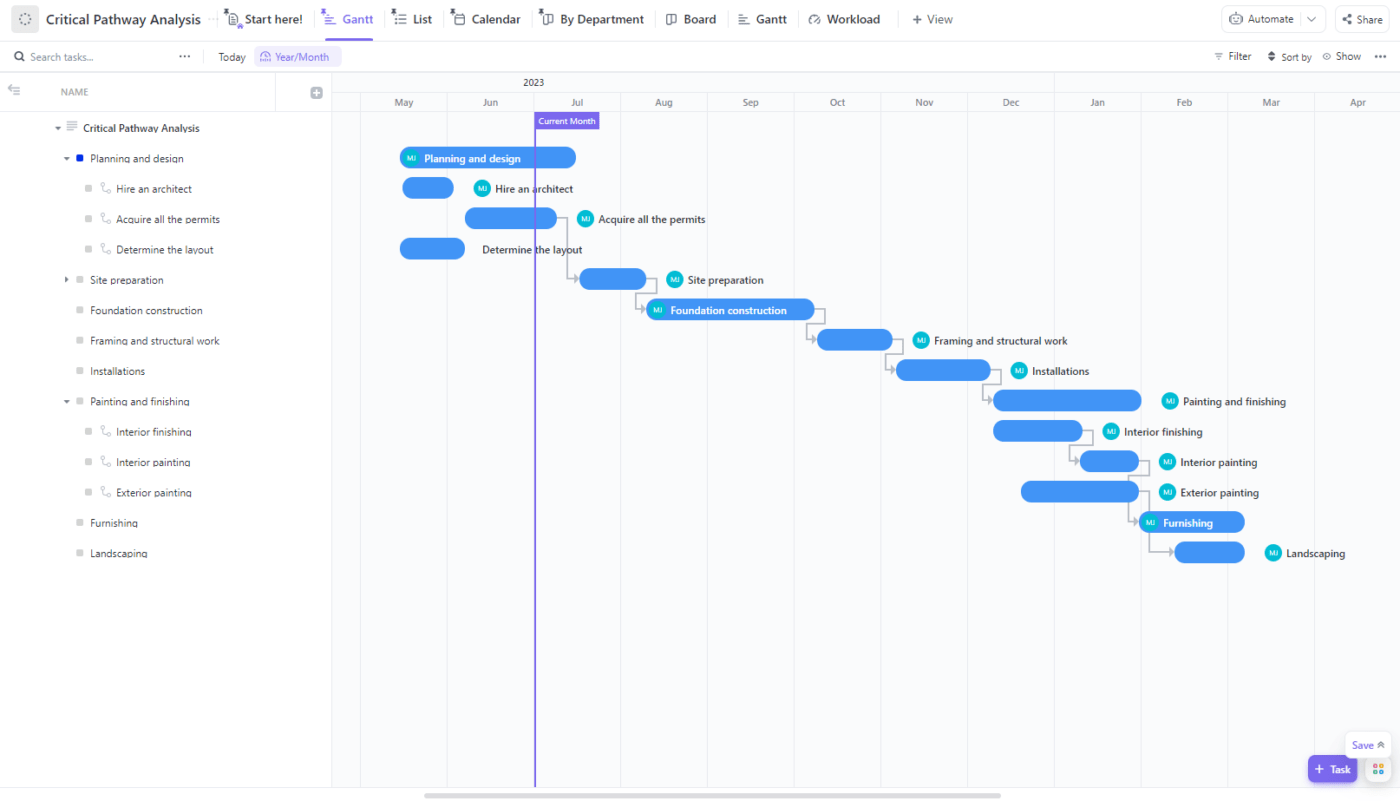
سهّل فهم الجدول الزمني لمشروعك باستخدام مخطط شبكي أو مخطط جانت الخاص ب ClickUp أو أي طريقة أخرى
يمكنك استخدام القلم والورقة، أو برنامج تحرير النصوص أو الرسم، أو برنامج إدارة المشروع مثل ClickUp. سبورة ClickUp's Whiteboard تتيح لك طريقة العرض تبادل الأفكار والتعاون مع فريقك في اتخاذ القرارات. يمكنك إنشاء مخططات WBS أو PERT جيدة المظهر في وقت قصير. استخدم الأشكال والموصلات لإنشاء الهيكل. أضف عناصر إضافية مثل الصور والمستندات لجعل المخطط أكثر إفادة.
كالعادة، يمكنك البدء بقالب لتوفير الوقت. يحتوي ClickUp على العديد من الأطر الجاهزة لتستخدمها، مثل هذا القالب العالمي قالب مخطط بيرت البياني لـ ClickUp PERT أو قالب مخطط بيرت البياني البسيط لـ ClickUp .
على الرغم من اختلافه من حيث الهيكل, مخططات جانت هي أيضًا طريقة ملائمة لتصور تسلسل المهام في المشروع وتقدير مدتها. في ClickUp، تكون مخططات جانت تفاعلية وقابلة للتكيف. فهي تمكّنك من رسم خارطة الطريق وجدولة المهام في نفس الوقت ببضع نقرات فقط.
الخطوة 4: تقدير مدة المهمة
الخطوة التالية هي تحديد t لكل مهمة، أي عدد الأيام التي ستستغرقها لإكمالها. قدّر بناءً على خبرتك والبيانات التاريخية ومعايير الصناعة. استشر الآخرين، لا سيما الخبراء، لاكتساب وجهات نظر متعددة والتوصل إلى أدق التوقعات.
أدخل المعلومات في الحقول المخصصة في طريقة عرض القائمة أو قم بتحديثها مباشرةً في طريقة عرض جانت عن طريق تغيير حجم أشرطة المهام.
الخطوة 5: تحديد المسار الحرج
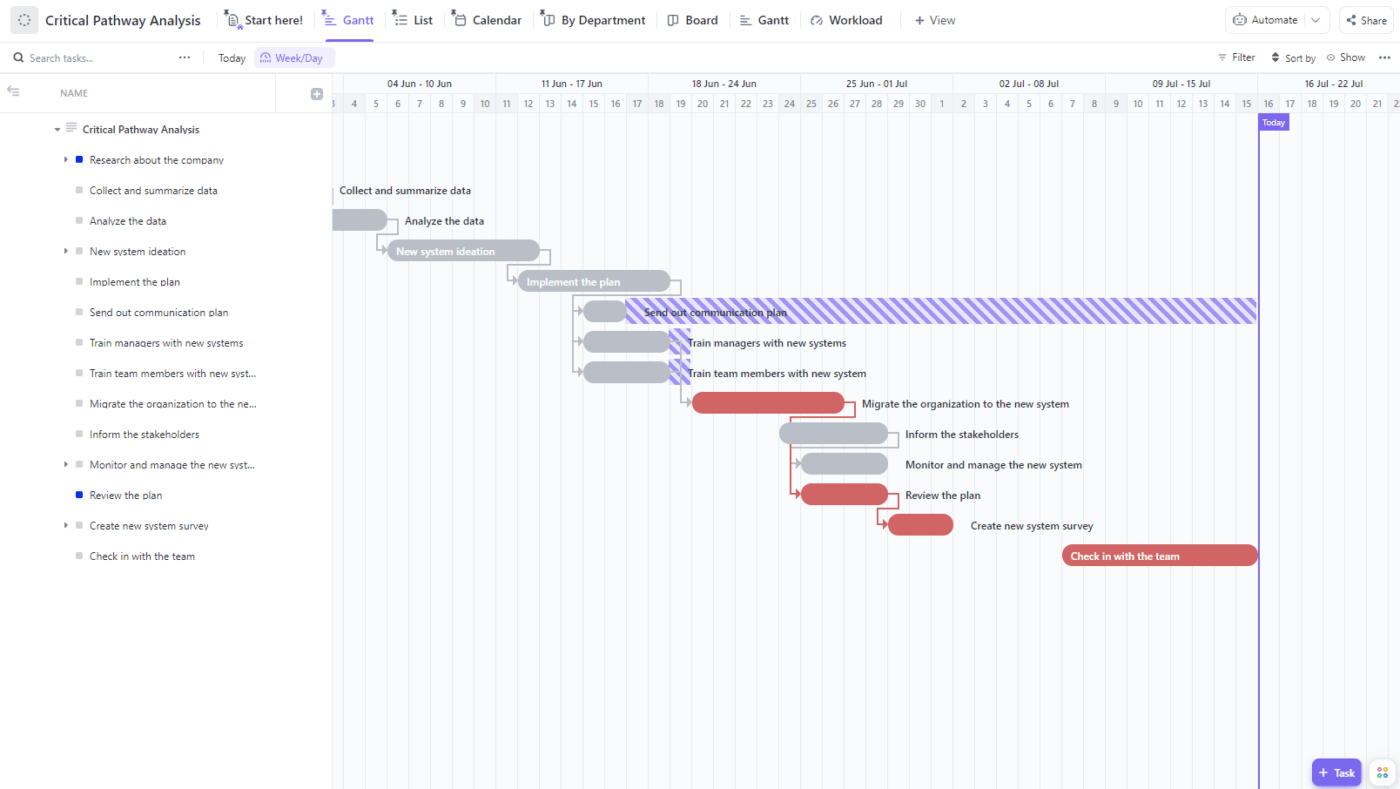
اكتشف أطول تسلسل للأنشطة الحرجة ومقدار المهلة المتاحة لك مع الأنشطة غير الحرجة
باستخدام المعادلات التي شاركناها سابقًا، احسب ES و LS و EF و LF والفترة الزمنية للركود. ابدأ بالمهمة الأولى، التي لها وقت بدء 1، ثم حدد EF و LF بناءً على مدتها. كرر الأمر نفسه مع جميع المهام الأخرى.
أطول تسلسل للأنشطة الحرجة (تلك التي لها فترة تباطؤ صفر) هو المسار الحرج.
هذه الحسابات أكثر قابلية للإدارة مع ClickUp Gantt View . في مخطط جانت للمشروع ، اختر الخيار إظهار مرة أخرى، ولكن هذه المرة، قم بتمكين المسار الحرج و/أو وقت التأخير .
سيظهر المسار الحرج مع نظام ألوان مختلف، مع إبراز المهام ذات التبعية المحظورة باللون الأحمر. 🛑
مع تمكين خيار الوقت الضائع، سيظهر شريط مخطط باللون الأرجواني إلى جانب الأنشطة غير الحرجة لتوضيح مساحة المناورة التي تسمح بها. 🟣
هناك طريقة أخرى للتمييز بين المهام الحرجة وغير الحرجة وهي إضافة علامات الأولوية والرموز اللونية. على سبيل المثال، يمكنك تعيين الأنشطة الحرجة بعلامة أولوية عالية والأنشطة غير الحرجة بعلامة أولوية منخفضة، وسيقوم البرنامج بتلوينها وفقًا لذلك.
الخطوة 6: التنفيذ والمراجعة
أخيراً، ابدأ بتنفيذ مشروعك مهمة تلو الأخرى. 🧱
أثناء قيامك بالمهام، قد تدرك أن بعضها ليس ضروريًا أو قد تواجه قيودًا غير متوقعة على الموارد. يُطلق على التأخير الناجم عن مثل هذه الأحداث المسار الحرج التأخير.
راقب الأنشطة عن كثب للتأكد من الالتزام بالجدول الزمني والتقاط أي تغييرات في الخطة في الوقت المناسب.
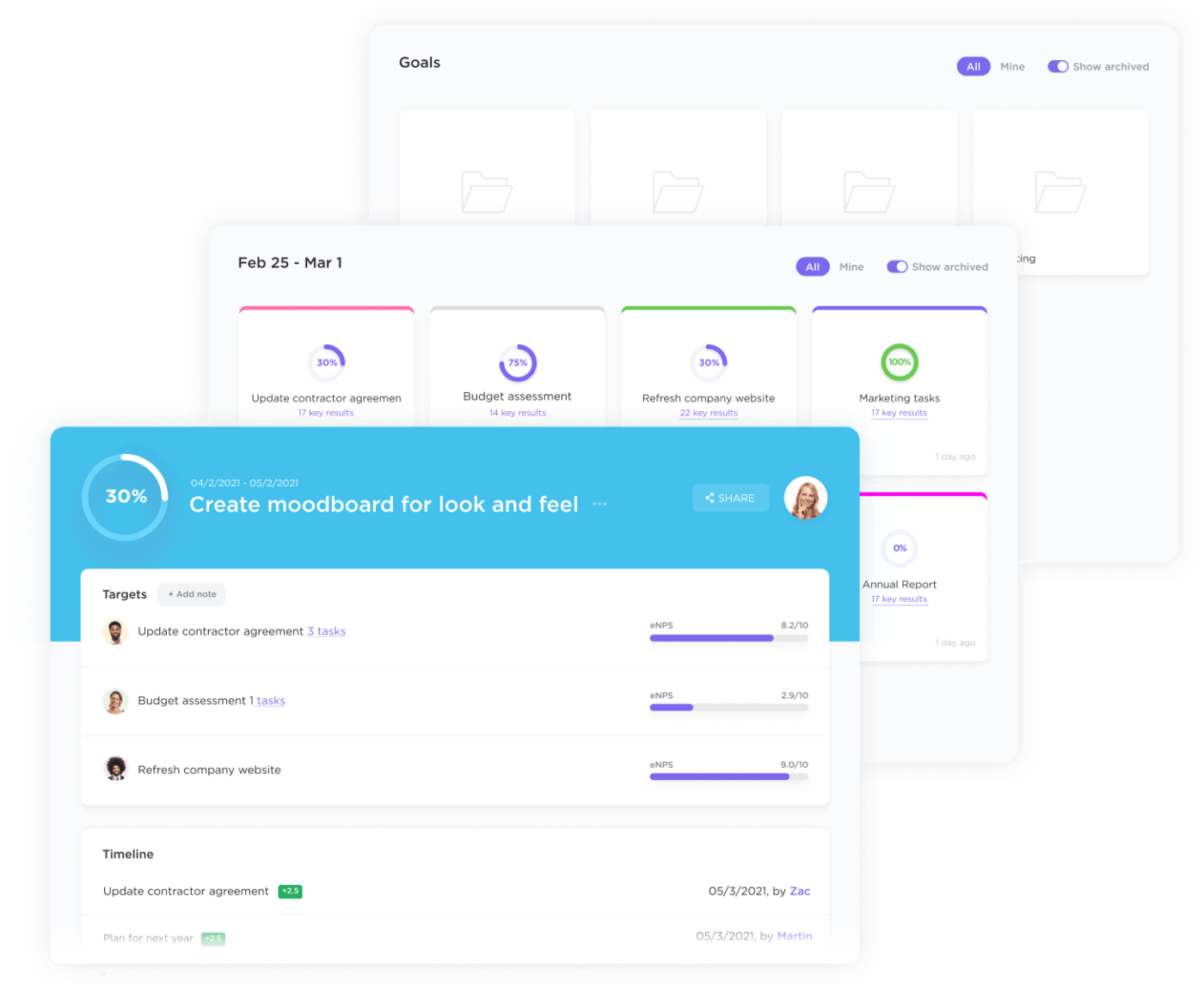
استخدم خاصية ClickUp تتبع الهدف ميزة البقاء على المسار الصحيح لتحقيق أهدافك من خلال جداول زمنية واضحة، وأهداف قابلة للقياس، وتتبع التقدم المحرز تلقائيًا
في ClickUp، يمكنك أهداف النقر وتتبع التقدم المحرز تلقائيًا. اختر من بين أهداف المهام والأهداف العددية والنقدية والصحيحة/الكاذبة، ثم قم بإدارتها كلها في مكان واحد. من خلال مراقبة أهدافك وتقدمك عن كثب، يمكنك ضمان بقاء مشروعك على المسار الصحيح في جميع الأوقات. 🛣️
مثال على تحليل المسار الحرج
هل تتذكر مثال بناء المنزل الذي ذكرناه سابقاً؟ دعنا نتوسع فيه! سنوضح لك كيفية تطبيق تحليل المسار الحرج على مثال واقعي.
سنستخدم نفس قالب تحليل المسار الحرج الخاص بـ ClickUp.

سرد جميع المهام، إلى جانب تواريخ الاستحقاق، والمكلفين بالمهام، والمستندات، وغيرها من المعلومات المهمة في قالب تحليل المسار الحرج ClickUp
دعنا نبدأ بـ سرد جميع المهام التي نحتاج إلى القيام بها لبناء منزل:
- التخطيط والتصميم
- إعداد الموقع
- بناء الأساسات
- أعمال الإطارات والأعمال الإنشائية
- التركيبات
- الطلاء
- التأثيث
- تنسيق الحدائق
سنقوم أيضاً بتدوين المهام الفرعية. على سبيل المثال، في مرحلة التخطيط والتصميم، ستشمل هذه المهام ما يلي:
- التعاقد مع مهندس معماري
- تحديد تصميم المنزل
الحصول على جميع التصاريح
سنقوم أيضاً بتحديد تاريخ بدء المشروع وتاريخ انتهائه
- من 18 مايو إلى 5 مارس
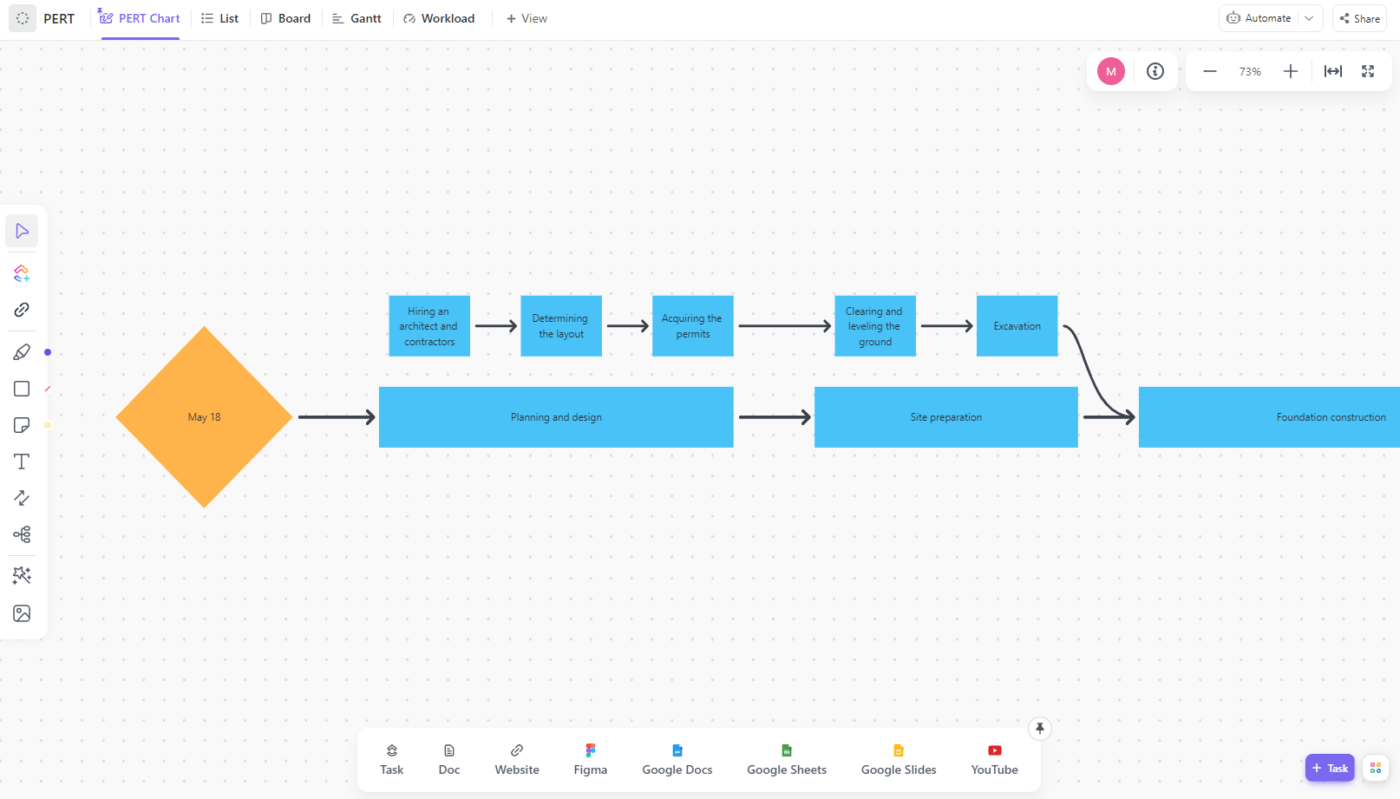
إنشاء رسم تخطيطي للجدول الزمني باستخدام قالب مخطط بيرت البياني ClickUp PERT
بعد ذلك، سنقوم بإنشاء رسم تخطيطي في طريقة عرض السبورة. سنستخدم قالب مخطط PERT البياني ClickUp PERT للبدء في ذلك. بالنظر إلى التبعيات وتخصيص أشكال أكبر للمهام التي تتطلب أطول وقت، سننشئ المخطط الانسيابي لتصور العمل القادم.
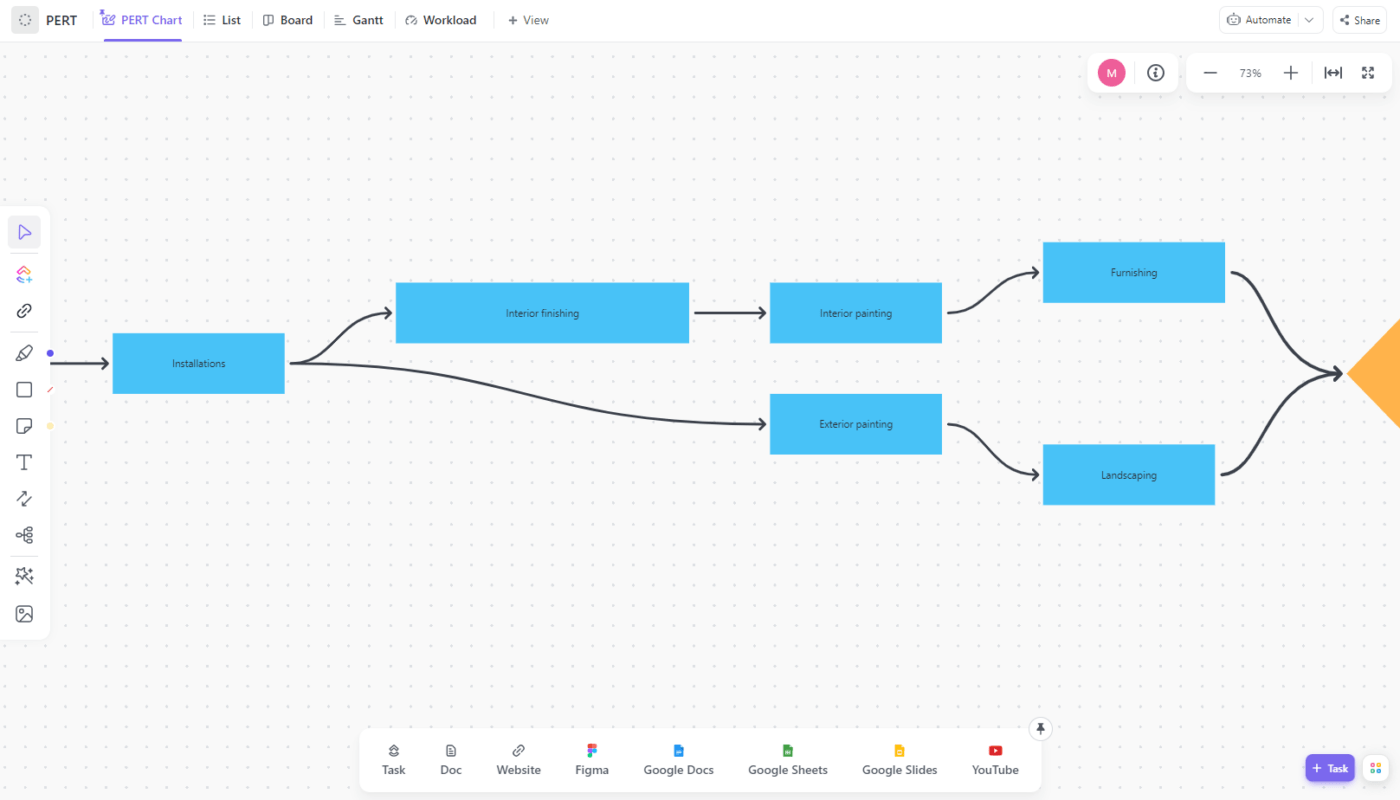
إنهاء المخطط، مع الانتباه إلى المهام المتوازية والتبعيات الأخرى
لاحظ كيف تتفرع الخطوات بعد خطوة التثبيتات؟ هذا للإشارة إلى أن
- يمكن أن يحدث الطلاء الخارجي في أي وقت بعد التركيبات
- لا يمكن إجراء الطلاء الداخلي حتى يتم الانتهاء من التركيبات
- يمكن إجراء الطلاء الداخلي والخارجي في وقت واحد، مما يعني أن هذه المهام متوازية
- لا يمكن إجراء عملية التأثيث حتى تجف أعمال الطلاء الداخلي
- لا يمكن أن تبدأ مرحلة تنسيق الحدائق حتى تجف أعمال الطلاء الخارجي
بعد الانتهاء من المخطط، اعرض التبعيات في القائمة أو طريقة عرض جانت.
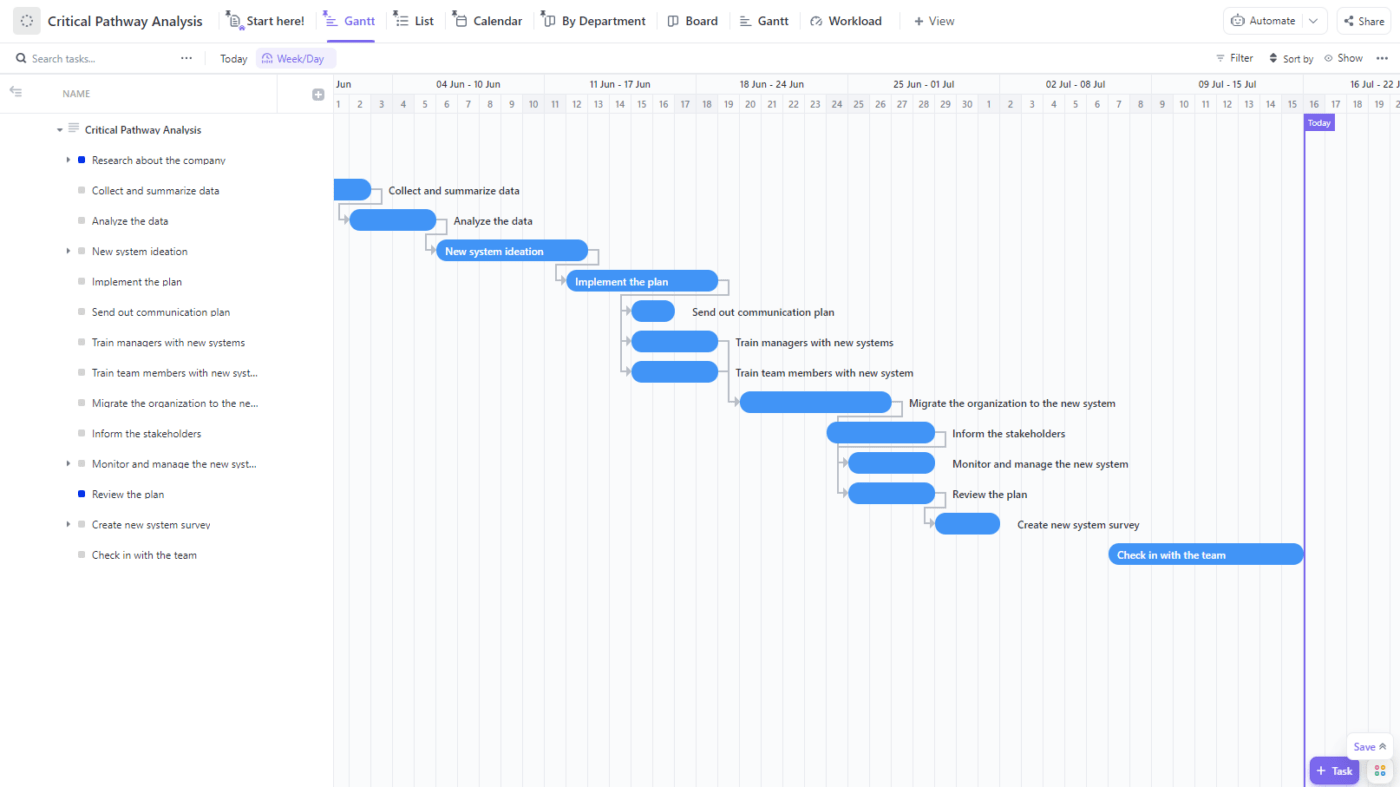
تقدير المدة الزمنية لكل نشاط وتكوين جدول زمني واقعي بمساعدة مخطط جانت
بعد ذلك، سنقوم بتقدير مدة المهام، وكتابة عدد الأيام في الحقل المخصص في طريقة عرض القائمة. بالنظر إلى هذه المعلومات، سنقوم بجدولة المهام و/أو المهام الفرعية في طريقة عرض جانت.
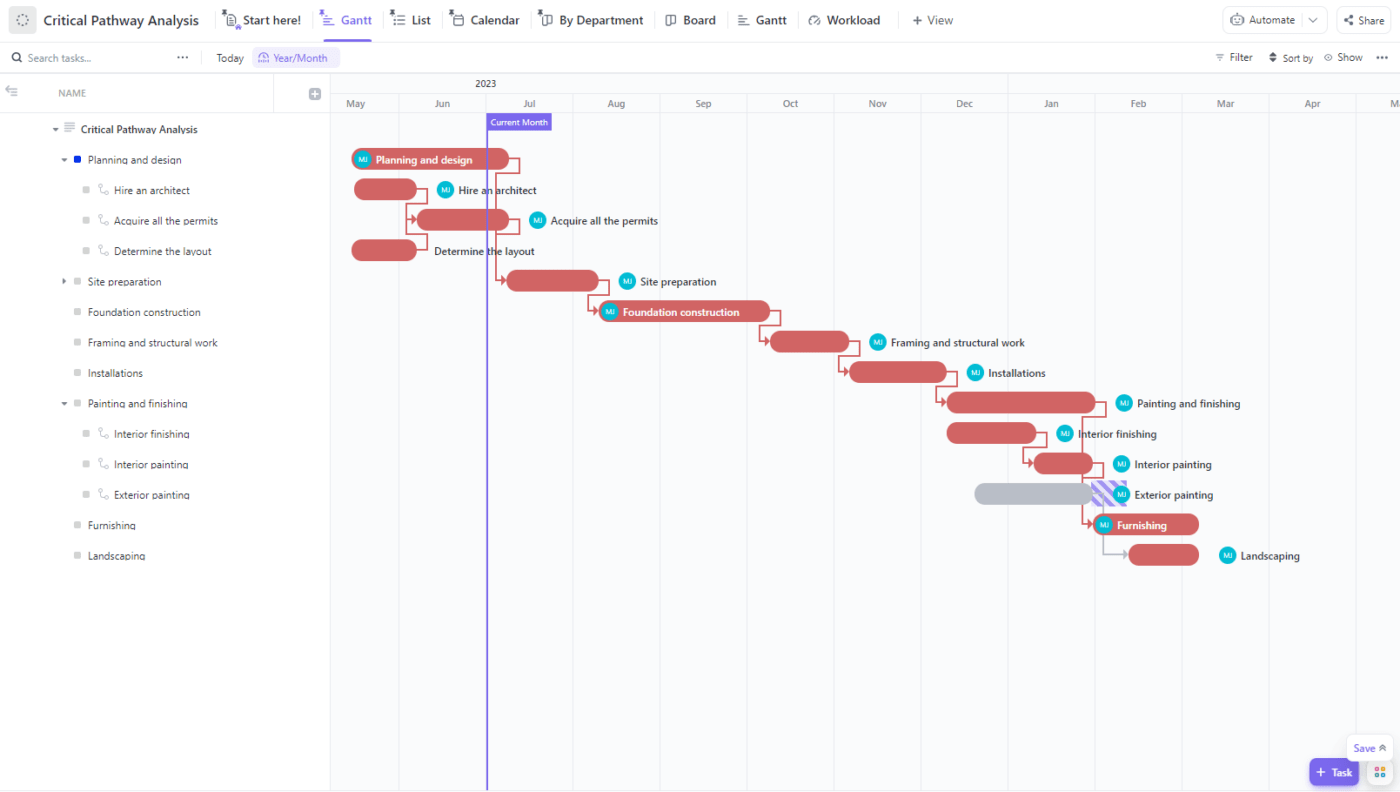
تحديد المسار الحرج للمشروع وتحديد فترة الركود للأنشطة المرنة وغير الحرجة
أخيرًا، سنقوم بحساب المسار الحرج والتراخي. في حالتنا، هناك فسحة صغيرة لأن معظم الأنشطة حاسمة.
كما ترون في الصورة أعلاه، فإن المهمة الوحيدة التي بها فترة تباطؤ هي الطلاء الخارجي. وبمجرد الانتهاء من التركيبات، يمكن أن يتم الطلاء الخارجي في أي وقت، شريطة تخصيص وقت كافٍ للتجفيف، وفي نهاية المطاف، تنسيق الحدائق.
لنفترض أنه حدث تغيير في الخطط، وطلب مقاولو الأرضيات لدينا إعادة جدولة الموعد في الأسبوع التالي. في هذه الحالة، سننقل شريط المهام الفرعية إلى مكانه الجديد. مع تفعيل خيار إعادة الجدولة التلقائية، سيتم تحديث المهام الأخرى وفقًا لذلك! ✔️
التنقل في الجداول الزمنية للمشروع مثل المحترفين باستخدام طريقة المسار الحرج
يمكن أن تكون طريقة المسار الحرج مساعدة ممتازة عند التعامل مع مشروع متطلب. فهي تمكّنك من تقييم المهام وتسلسلها بدقة، مما يضمن لك الوفاء بالمواعيد النهائية والحفاظ على الجدول الزمني للمشروع والحفاظ على علاقات سليمة مع العملاء، ودفع عجلة التقدم والنمو الفعلي.
عندما يتم فرز مهامك، فإن بقية المشروع يقع في مكانه الصحيح.
باستخدام أداة مثل انقر فوق يمكنك تجربة CPM مجانًا وبأقل جهد ممكن. ابدأ اليوم! ✨

